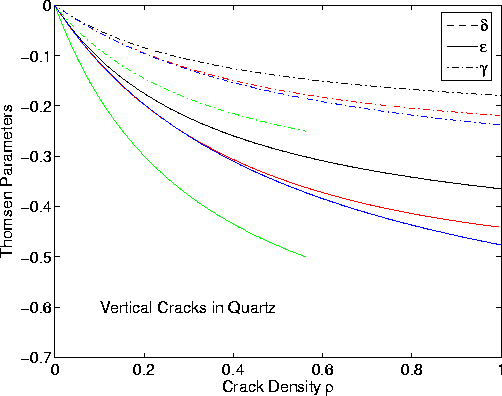 | ||
A transversely isotropic material is one with physical properties which are symmetric about an axis that is normal to a plane of isotropy. This transverse plane has infinite planes of symmetry and thus, within this plane, the material properties are the same in all directions. Hence, such materials are also known as "polar anisotropic" materials.
Contents
- Example of transversely isotropic materials
- Material symmetry matrix
- Transverse isotropy in physics
- Condition for material symmetry
- Elasticity tensor
- Transverse isotropy in geophysics
- Backus upscaling Long wavelength approximation
- Short and medium wavelength approximation
- Thomsen parameters
- Simplified expressions for wave velocities
- References
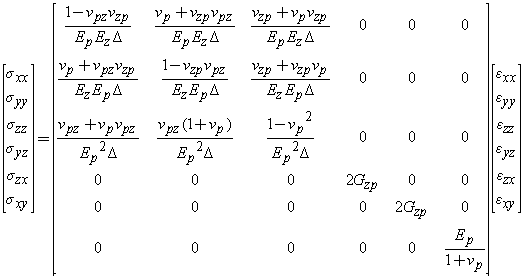
This type of material exhibits hexagonal symmetry (though technically this ceases to be true for tensors of rank 6 and higher), so the number of independent constants in the (fourth-rank) elasticity tensor are reduced to 5 (from a total of 21 independent constants in the case of a fully anisotropic solid). The (second-rank) tensors of electrical resistivity, permeability, etc. have 2 independent constants.
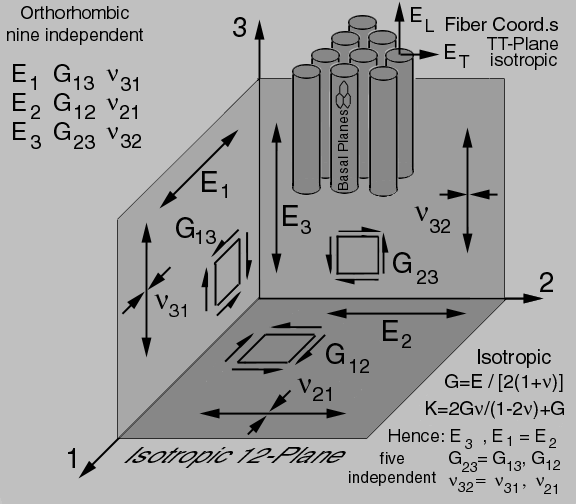
Example of transversely isotropic materials
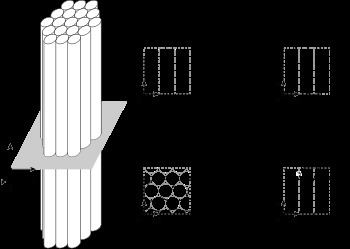
An example of a transversely isotropic material is the so-called on-axis unidirectional fiber composite lamina where the fibers are circular in cross section. In a unidirectional composite, the plane normal to the fiber direction can be considered as the isotropic plane, at long wavelengths (low frequencies) of excitation. In the figure to the right, the fibers would be aligned with the
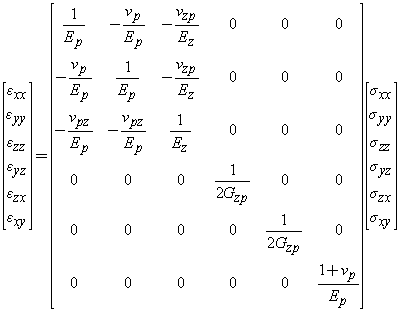
In terms of effective properties, geological layers of rocks are often interpreted as being transversely isotropic. Calculating the effective elastic properties of such layers in petrology has been coined Backus upscaling, which is described below.
Material symmetry matrix
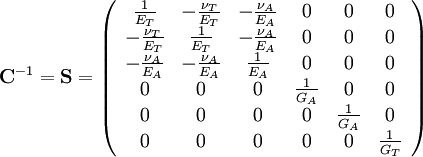
The material matrix
Hence the condition for material symmetry is (using the definition of an orthogonal transformation)
Orthogonal transformations can be represented in Cartesian coordinates by a
Therefore, the symmetry condition can be written in matrix form as
For a transversely isotropic material, the matrix
where the
Transverse isotropy in physics
Linear material constitutive relations in physics can be expressed in the form
where
Examples of physical problems that fit the above template are listed in the table below
Using
Condition for material symmetry
In linear elasticity, the stress and strain are related by Hooke's law, i.e.,
or, using Voigt notation,
The condition for material symmetry in linear elastic materials is.
where
Elasticity tensor
Using the specific values of
The elasticity stiffness matrix
The compliance matrix (inverse of the elastic stiffness matrix) is
where
Comparing these two forms of the compliance matrix shows us that the longitudinal Young's modulus is given by
Similarly, the transverse Young's modulus is
The inplane shear modulus is
and the Poisson's ratio for loading along the polar axis is
Here, L represents the longitudinal (polar) direction and T represents the transverse direction.
Transverse isotropy in geophysics
In geophysics, a common assumption is that the rock formations of the crust are locally polar anisotropic (transversely isotropic); this is the simplest case of geophysical interest. Backus upscaling is often used to determine the effective transversely isotropic elastic constants of layered media for long wavelength seismic waves.
Assumptions that are made in the Backus approximation are:
For shorter wavelengths, the behavior of seismic waves is described using the superposition of plane waves. Transversely isotropic media support three types of elastic plane waves:
Solutions to wave propagation problems in such media may be constructed from these plane waves, using Fourier synthesis.
Backus upscaling (Long wavelength approximation)
A layered model of homogeneous and isotropic material, can be up-scaled to a transverse isotropic medium, proposed by Backus.
Backus presented an equivalent medium theory, a heterogeneous medium can be replaced by a homogeneous one which will predict the wave propagation in the actual medium. Backus showed that layering on a scale much finer than the wavelength has an impact and that a number of isotropic layers can be replaced by a homogeneous transversely isotropic medium that behaves exactly in the same manner as the actual medium under static load in the infinite wavelength limit.
If each layer
The elastic moduli for the effective medium will be
where
This includes isotropic layers, as the layer is isotropic if
Short and medium wavelength approximation
Solutions to wave propagation problems in linear elastic transversely isotropic media can be constructed by superposing solutions for the quasi-P wave, the quasi S-wave, and a S-wave polarized orthogonal to the quasi S-wave. However, the equations for the angular variation of velocity are algebraically complex and the plane-wave velocities are functions of the propagation angle
where
Thomsen parameters
Thomsen parameters are dimensionless combinations of elastic moduli which characterize transversely isotropic materials, that are encountered, for example, in geophysics. In terms of the components of the elastic stiffness matrix, these parameters are defined as:
where index 3 indicates the axis of symmetry (
The name refers to Leon Thomsen, professor of geophysics at the University of Houston, who proposed these parameters in his 1986 paper "Weak Elastic Anisotropy".
Simplified expressions for wave velocities
In geophysics the anisotropy in elastic properties is usually weak, in which case
where
are the P and S wave velocities in the direction of the axis of symmetry (
The approximate expressions for the wave velocities are simple enough to be physically interpreted, and sufficiently accurate for most geophysical applications. These expressions are also useful in some contexts where the anisotropy is not weak.
